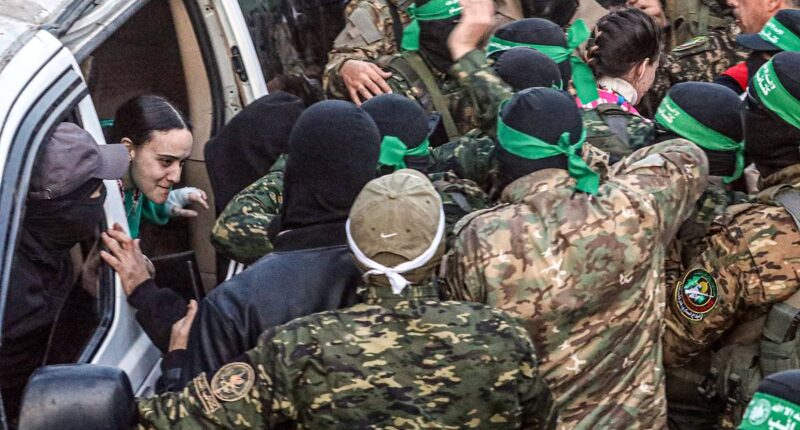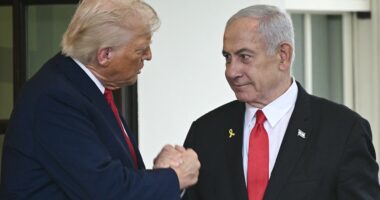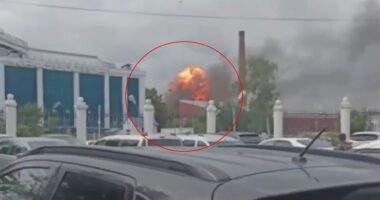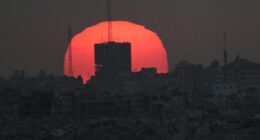Nothing better illustrates why the Gaza ceasefire deal is so tenuous than the sickening scenes today.
Even after being freed, the three Israeli hostages had to navigate through a hostile armed crowd under Hamas’s orders, as they anxiously boarded a Red Cross van.
It is crucial to understand that the current ceasefire does not equate to a peace agreement. Instead, it signifies a temporary halt, with only 30 more individuals out of the remaining hostages set to be released in the following six weeks. With approximately 91 captives still believed to be held in Gaza, out of the original 250 individuals abducted on October 7, 2023, and some of them unfortunately deceased, the process of complete hostage release is far from over.
Under the new deal, negotiations over the rest of the hostages will only start on February 4, after 16 days of ceasefire.
At the heart of the matter lies a significant condition. For all hostages to be released, Israel must commit to removing its troops and terminating the ongoing conflict. However, Israel remains hesitant to agree to these terms until there is a guarantee that Hamas will no longer govern Gaza. Thus, it’s essential to realize that the recent hostage release does not signify a resolution on the horizon.

First sighting of British-Israeli Emily Damari Emily Damari being released

Ms Damari was kidnapped during the October 7 attacks and has been a hostage for 470 days
Israel’s basic aim has been to destroy Hamas as a significant terror threat. It has certainly decimated its armoury, as well as wiping out its leadership. Israel says it has killed at least 18,000 of its terrorists – although last week US Secretary of State Antony Blinken said Hamas has recruited just as many new fighters.
But what really matters is whether Hamas has power over Gaza and whether it is capable of repeating an October 7-style massacre, as their new leader has promised.
So the focus of negotiations needs to be on how and by whom Gaza is governed and – crucially – the role of Iran, which funds Hamas.
Do not fall for the Hamas propaganda that it is wildly popular among Gazans. In November, for example, Professor Salman al-Dayah, a respected Sharia academic at Gaza’s Islamic University, issued a fatwa reprimanding Hamas for the October 7 massacre and for its policy of using using human shields by basing fighters in civilian buildings.
Ensuring that Israel kills Palestinian civilians in any military action has always been a key part of Hamas’ strategy, described by Yahya Sinwar, the former Hamas leader killed by Israel, as a ‘necessary sacrifice’.
Al-Dayah condemned Hamas for not ‘keeping fighters away from the homes of defenceless [Palestinian] civilians and their shelters and providing security and safety as much as possible in the various aspects of life’.
Reliable polling is obviously not easy in Gaza, but a survey last month by Arab World for Research and Development found that a mere 16 per cent of Gazans said they would vote for Hamas if there were elections to the Palestinian parliament.

Doron Steinbrecher was abducted from her apartment in Kibbutz Kfar Aza – near Gaza’s north-western border

Romi Gonen was snatched from the Nova music festival
By far the most popular option is some sort of national unity government involving Islamists, technocrats and parties which – unlike Hamas – want a two-state solution.
One widely mooted possibility is that Arab states such as the United Arab Emirates and even Qatar, which has supported Hamas by hosting its headquarters and leadership, and which helped broker the ceasefire, might get involved in both the administration and rebuilding of Gaza.
But this is all pie in the sky for the moment. Why would any nation spend billions on Gaza when the usual cycle could resume and Israel could be forced again to take military action to defend itself from Hamas terror?
Which brings us to Iran. The reality is that while the Iranian regime is able to fund and direct its proxies – Hamas, Hezbollah in Lebanon and the Houthis in Yemen – no real progress is possible. Dealing with Iran is a prerequisite – not just for Gaza, but for the whole Middle East.
In this context, Donald Trump’s return is pivotal. He has credit in the bank with the Gulf states having secured the historic Abraham Accords in his first term in office. He also brought the Saudis to the brink of a deal with Israel.
And not only does he understand Iran’s poisonous role, he is prepared to use the US’s might to tackle it – as he showed in his first term when he ripped up Barack Obama’s feeble nuclear deal with Tehran and re-imposed serious sanctions on its mullahs.
There are suggestions that he pushed Israel towards accepting the ceasefire with the promise that in return he would back, or even instigate, a strike on Iran.
Today’s hostage release was a wonderful moment for their families. But we cannot be blindly optimistic that this is the end of the conflict.

















